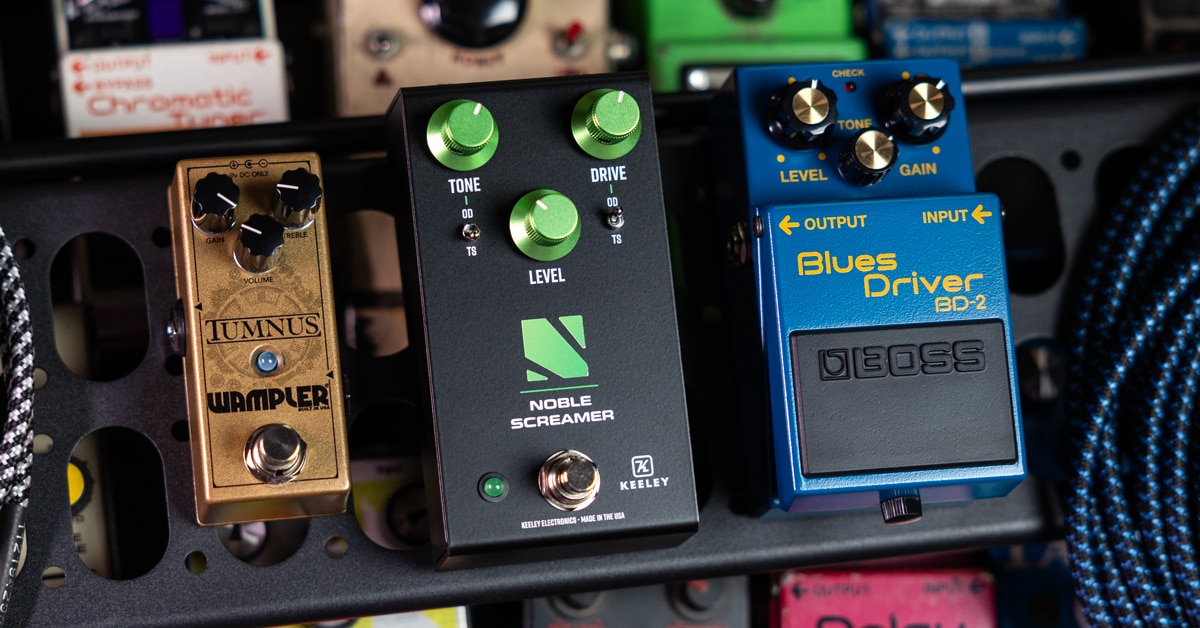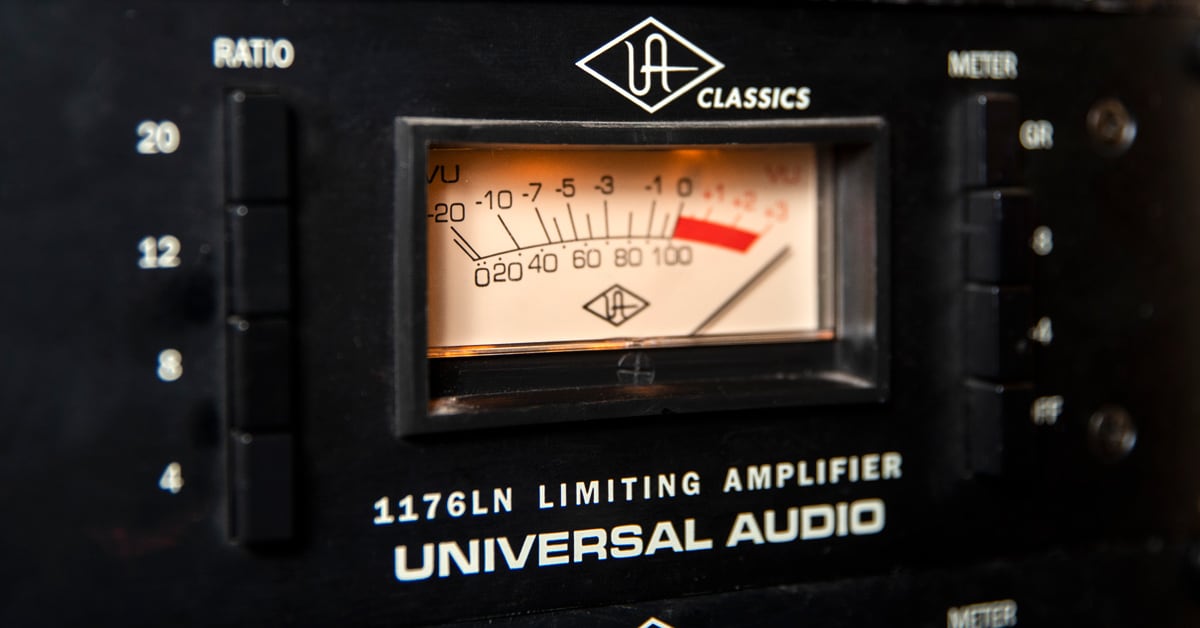It was one of those glorious fortunes of history that visionary audio engineer Bill Putnam released his Universal Audio 1176 Limiting Amplifier in 1967—the year of the Summer of Love. During that naïve, youth-driven celebration of unfettered possibilities and cultural tumult, Putnam, who was 47 years old at the time (and so a part of the old-guard that he was Frank Sinatra’s favorite engineer), nonetheless created a device that had a seismic effect on how people perceived recorded music—especially that of the new-dawn hippies, hipsters and hooligans who became legends of rock.
The 1176 was like some beautifully feral evangelist testifying to the end of the world as you knew it. Suddenly, the all-transistor 1176 compressor—with its super-fast attack—made it possible for engineers, producers and artists to ram guitars, drums, vocals and other mix elements so in-your-face that it almost seemed like the music was beamed right into your brain. As a result, the 1176 became an indispensable sonic component of classic albums by Led Zeppelin, the Rolling Stones, Michael Jackson and other legendary artists. It continued to be an essential tool for iconic albums by Beyoncé, U2, Alicia Keys, 50 Cent and so many more—even up to the new song you loved hearing today. And think about this: How many musicians—or pieces of gear—can boast a continuous and abundant string of hits across myriad genres for 56 years? The 1176 must hold a Guinness World Record for that fact alone.
Incredibly, the 1176 was just one of Putnam’s innovations, and his impact on the recording arts—from console design to rack gear to engineering techniques—informs how we work in the studio and make records to this day. Putnam was also quite the wheeler and dealer, so he tended to establish, grow and sell companies with regularity—Universal Audio being one of them. But, ten years after Putnam passed away in 1989, his sons Bill Jr. and Jim revived the brand, and the company currently produces hardware and digital versions of their father’s vintage processors, as well as plug-ins, audio interfaces and other gear developed by the current team.
Table of Contents
What Makes the 1176 Such a Legendary Compressor for Recording?
Seeking Excellence: A History of 1176 Hardware Revisions
5 Savvy User Tips for the 1176
A Guide to Current Universal Audio 1176 Hardware and Software Options
A List of Compressors Inspired by the Universal Audio 1176
One Caveat to the Brilliance of the Universal Audio 1176—By Its Inventor
What Makes the 1176 Such a Legendary Compressor for Recording?
Although it’s an overused term, Putnam was truly a virtuoso, finding success as an inventor, songwriter, entrepreneur, engineer, producer, record company executive and studio designer. While Putnam and guitarist/producer Les Paul were both crucially important to the concept and application of multitrack recording, Putnam alone owns the glory for the first use of artificial reverb on a pop song (the bathroom “echo chamber” on “Peg o’ My Heart” by the Harmonicats in 1947). Putnam certainly knew his way around a studio, both technically and creatively, and while he had designed tube consoles and compressors—such as the versatile and musical-sounding Universal Audio 175B and 176 Limiting Amplifiers—by the mid 1960s, he was eyeing the benefits of utilizing solid-state FET (field-effect transistor) circuitry.
While the ever-curious Putnam was likely enthused about diving into a new technology, he was also motivated to better address preventing scorching audio transients from distorting broadcast transmissions. Obviously, there was a listener-quality issue at hand, but also a financial consideration, as the FCC could fine a radio station for sending splattered audio over the airwaves.
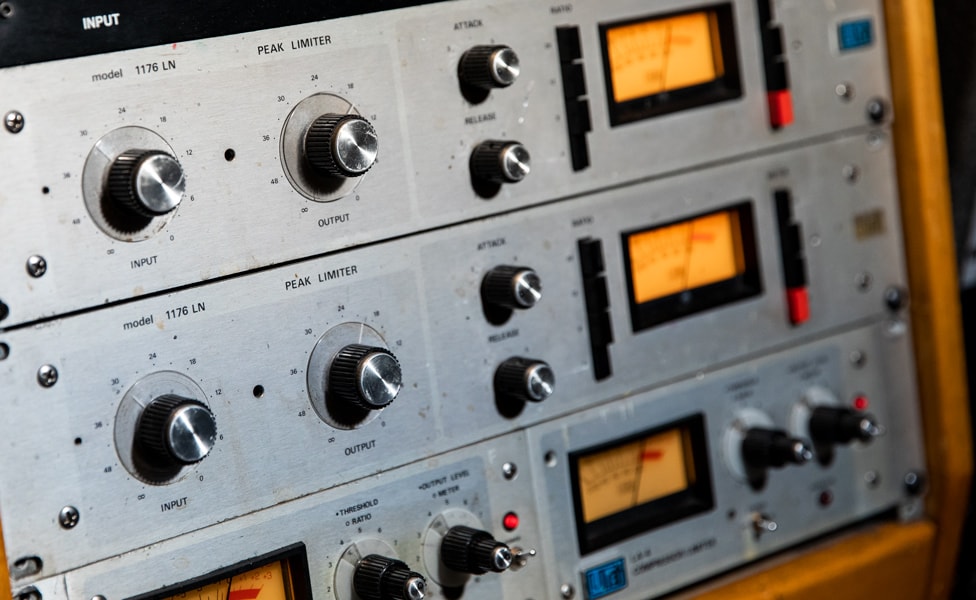
“The key was to limit an incoming signal quickly,” said Bill Putnam Jr., explaining his father’s development of the 1176 in a 2019 interview with Musician's Friend. “The voltage-variable behavior of the FET was extremely fast, so my father was able to develop a 20-microsecond attack [for input signals]. Until then, there were a lot of optical compressors [a circuit where a light element and optical cell are deployed to decrease the level of an output signal], but the ballistics of turning on an optical element slowed down the attack.”
The 1176’s fast-as-the-Flash attack and release times—which impact how quickly the compression turns on and off—were instant hits with audio professionals the moment the compressor was available. All of a sudden, spontaneous dynamic leaps—a surprising cymbal crash, the whisper-to-holler vocals of R&B-styled shouters such as Otis Redding and Janis Joplin, over-enthusiastic horn accents and more—were seamlessly manageable. But controlling dynamics wasn’t the sole genius of the 1176. The magic in Putnam’s design could also punch up signals with a glorious blend of grit, crunch and harmonic articulation that transformed anything sent to an 1176 to become seductively “more than” the original, unprocessed sound. For example, try to think of the drums on the Knack’s “My Sharona” without an 1176 squashing the room mics to deliver the massive eruption of groove you hear on the record. Or Michael Jackson’s supernaturally present voice on Thriller sans the 1176 that engineer Bruce Swedien used to record all of the King of Pop’s vocals.
But there’s a lot more.
From expressively overdriven bass tracks to ferocious-sounding guitars, the 1176 imparts so much sonic charisma to an audio production that it often becomes an instrument in itself—no less a vibe energizer than a soaring string section, percussion barrage, organ and piano counterpoint lines or horn punctuations.
Then, there are the buttons. Well, to be more specific, we’re not talking the four buttons to set the meter view—providing necessary, but not very thrilling, options to monitor gain reduction—but the quartet that determines Ratio (4:1, 8:1, 12:1, 20:1). Seems simple, right? You press a button to choose a ratio setting. However, while the buttons were originally designed for a single selection at a time—pushing one button deselects the others—some rowdy and subversive British recording engineer discovered you could actually push all four buttons in at once. That changed everything. “All Buttons In” mode unleashed a benevolently cataclysmic harmonic distortion that intensified and defined the sound of rock and roll. It was as if the 1176 was waiting for a pop-culture upheaval—and its impact on music making and audio mixing—to reveal its “secret weapon” to an unsuspecting, but extremely willing audience.
To better understand how this audio wonderland occurs, let’s take a look at what ratio settings mean on a compressor. Basically, those ratio numbers—which represent decibels—signify the amount of compression you are imposing on a signal, once it crosses the threshold level and the compressor starts its work. Most compressors let you set the threshold in decibels via a dedicated control (a typical setting is -50dB to 0dB), but the 1176 design didn’t have one. If you wanted more compression, you simply turned up the Input knob. Let’s say you choose a ratio setting of 2:1. This means any signal exceeding the threshold level by 2dB will be reduced by 1dB. Choose, say, 8:1, and signals popping over the threshold by 8dB will be attenuated down to a 1dB output. There will be no compression at all if you set the ratio to 1:1 (1dB in equals 1dB out, or “unity gain”). On a practical note, you can consider a ratio of 2:1 as subtle compression (smooth, transparent gain reduction), 4:1 as medium (you may hear changes to tone and articulation) and 10:1 as pretty aggressive (audible squash). A setting of 20:1 is usually defined as “limiting,” because the signal is prohibited from even taking a peek over the threshold level.
You can ruin the mystery of the 1176’s sound by visiting any number of sites that will detail the secrets of its operation. But there will always be an element of the unknowable, as Putnam designed the 1176 to be program dependent. Transients are addressed depending on the ratio you choose, but the ratio increases to some degree—precisely what degree is contingent on the audio material—as the transient subsides. It’s fitting that the music ultimately controls what the circuitry produces, because the 1176 can be one of the most musical, transparent, present or aggressive compressors out there, depending on the creative wishes of the engineer/producer operating it, as well as the conduct of the audio signal it receives.
Seeking Excellence: A History of 1176 Hardware Revisions
Bill Putnam Jr. said his dad was always returning to his designs to improve them—a fact verified by notes in Bill Sr.’s technical logs. And, as much as the 1176 was an enormous success upon its 1967 debut, it was a very good thing Putnam and his staff (more on this later on) evolved the circuitry, because the 1176 was initially a noisy beast. Early adopting engineers and producers obviously balanced the 1176’s audible noise with the sonic benefits it delivered, but the Universal Audio team was savvy enough to understand the recording industry was developing cleaner and cleaner signal paths for consoles, outboard gear and tape machines. Here is a revision timeline on the improvements sought and created by Putnam and the Universal Audio company.
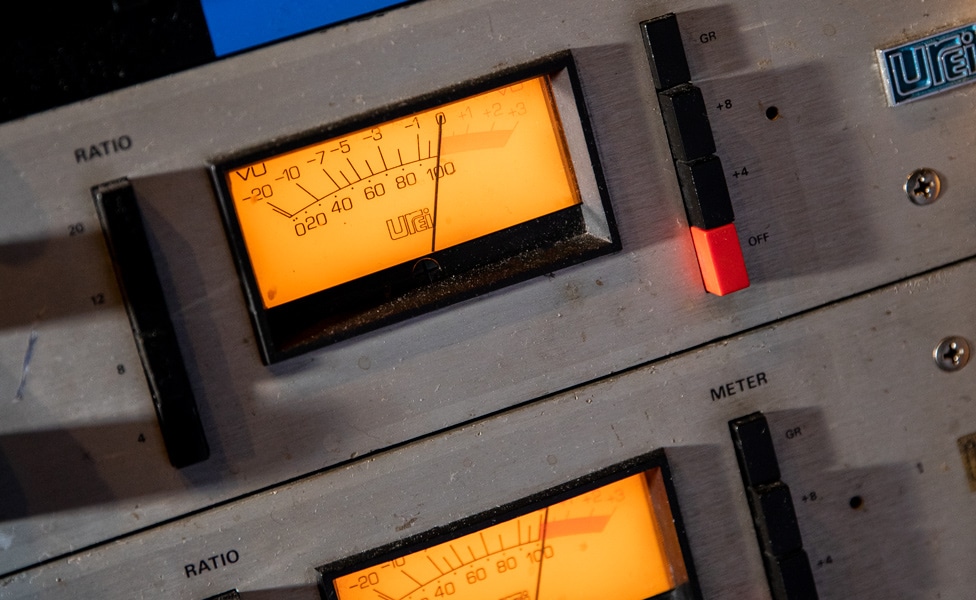
Original A Version. Putnam created the initial 1176 scheme on June 20, 1967, with a Class A design and the first instance of FET technology used as a voltage-variable resistor to manage gain reduction. This model—as well as revisions A, AB and B—is also known as the “Bluestripe,” because of the blue paint that’s under the VU meter. For vintage studio zealots, the A version is not surprisingly the most cherished, prized and desired 1176 model.
Revision AB. The OG was out only a few months before Putnam dove back into the design on November 20, 1967, to change resistor values to improve noise. Digging a bit deeper, a bypass cap was added to the resistor sending signal to the gain-reduction FET that resulted in a more stable and manageable limiter.
Revision B. Attributed to sometime in 1968, the FETs in the preamp were swapped out for a 2N3391A bipolar transistor to amplify the signal.
Revision C. This was the big one. Twenty-nine year old engineer Brad Plunkett—who also created the modern, commercial wah pedal for Thomas Organ/Vox in 1966—went to work for Putnam in October 1969. In 1970, Plunkett designed the low-noise “LN” module to reduce voltage to the gain-reduction FET and keep it within its linear range. In addition, a trimpot was added to a feedback circuit to further minimize distortion. These electronic changes were so significant that the C model was named 1176LN, and the front-panel color was changed to black—a look that carried on up to revision G.
Revision D. In the longest timespan between revisions, the D version did away with the LN module and incorporated it on a redesigned circuit board in 1973. So, what impact did that modification have on the sound? We don’t have an actual A, AB, B or C to compare, but vintage Ds are rather prominent in upper-scale studios, where it’s typically the go-to compressor for just about everything. The D is known for a robust low end and an almost imperceptible smoothing out of the program material. It also delivers a nice creamy midrange emphasis that really shines on guitars and basses, as well as adds some spark to impassioned vocal tracks.
Revision E. A power transformer was added so that the voltage could be switched between 110V and 220V operation. This revision also occurred sometime in 1973, as did the following F, G and H versions. The versatility of dual-voltage operation made it easy for studios across the globe to incorporate 1176s into their racks, but the sound of the E revision is reportably almost identical to the C and D versions.
Revision F. The output amplifier is changed from Class A to a Class AB push-pull design in order to produce more output drive. Furthermore, the output transformer is switched to a Bournes B11148 with 12dB of gain, as well as an alleged boost in the low and super-high frequencies. Despite the additional output, the F version delivers the lowest harmonic distortion of any revision, and it is known as the one to get if you want 1176 compression, but with a bit less 1176 attitude. This assessment is typically validated whenever D revisions are compared to the F version, which doesn’t serve up much of a boost in the meaty and deep low-end ranges. The good news here is if you are a fan of relatively transparent compression, the F revision will be delightful, but it’s also far from a bland sound. There’s a nice presence and bite to the mids and highs—a subtle sheen, so to speak. It’s also interesting to note that Revision F 1176s are significantly more populous than the earlier versions. So, if you see a vintage 1176 in a studio, you can bet your band mates that it’s an F, and likely have a great chance at pocketing some winnings.
Revision G. The input transformer is replaced with a differential-input, op amp stage, and the circuitry is no longer program dependent.
Revision H. Mostly cosmetic amendments. The Universal Audio branding changed in favor of a blue UREI (United Recording Electronics Industries) logo, and the front panel got a brushed-aluminum treatment (known as “Silverface”) and a red Off button.
Revision/Reissue UA 2000. As stated previously, Universal Audio was revived in 1999 by two of Putnam’s sons. The first product of the restarted company was released on April 1, 2000. This was a hardware reproduction of the black-panel 1176LN based on the C, D and E revisions—which are reportedly the most treasured versions of the original model updates. Bill Putnam Jr. used his dad’s notes to ensure the reissues are accurate, although he also improved elements where he could—which kind of honors and points back to his father’s obsession with tinkering and releasing enhanced revisions of his initial designs.
Anniversary Edition. In the spirit of being comprehensive, we’ll mention the June 4, 2008, Anniversary model—even though only 500 were manufactured. This is where we say, “Good luck trying to find one, afford one and acquire it.” However, if you can grab one for yourself, you should, as the 2008 revision offered enhanced Attack settings, slightly mellower compression ratios, expanded multi-button options and a return to that retro and vibey program-dependent operation.
5 Savvy User Tips for the 1176
There’s an old, funny story about how American and British recording engineers worked differently back in the ’60s and ’70s. It might even be true. The anecdote stated that Americans would read the manuals thoroughly for a piece of gear before doing anything with it. The British? They’d just plug stuff right in and smack knobs around until something interesting happened. The manuals stayed in the product’s packing materials.
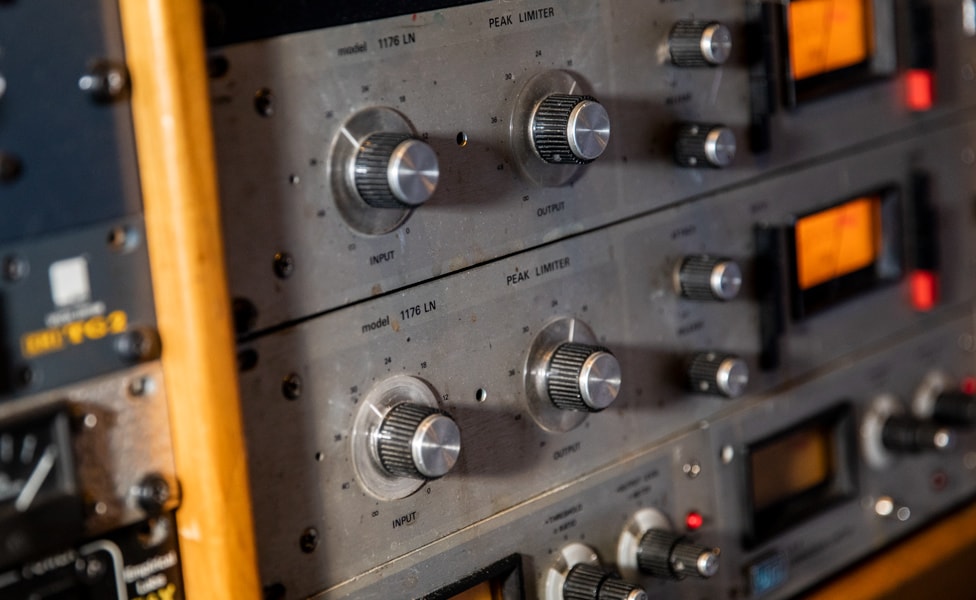
What’s to be learned from this perhaps fanciful narrative? Perhaps it’s that reading manuals is a good practice, but sticking exclusively to the book might inhibit creativity. In this section, we will share some time-honored methods for getting first-rate results from hardware and software versions of the 1176, but don’t hesitate to try something silly and outlandish. After all, the 1176’s world-changing “All Buttons In” mode wasn’t discovered by following the rules. And, by the way, it was a British engineer that first dared to push in all four Ratio switches at once. (There may be some truth to that old story after all ...)
Use the “Dr. Pepper” Setting for Light Compression
This one is conceptually strange—especially as few musicians likely remember the “vintage” Dr. Pepper soft drink campaign about boosting your energy with a bottle of the Dr. at 10 a.m., 2 p.m. and 4 p.m. It’s a pre-Monster Energy Drink thing. The tip is to start with the Attack knob set at 10 o’clock, the Release control at 2 o’clock and the 4:1 Ratio button depressed. Apparently, a fair amount of engineers begin their compression settings at 10-2-4, and even Universal Audio recommends the soda-pop application. But remember, this setting is simply an opening move in the chess game of compression. Listen to how “Dr. Pepper” sounds, but explore other settings until you hear what you want.
Go All In for Explosive Drums and Other Sounds
We’ve discussed the notorious “All Buttons In” mode, and you should definitely explore that tactic, as it drastically pumps up compression overdrive and distortion to deliver otherworldly fierce results. However, you should also check out other multi-button combinations—4 and 8, 8 and 12 and so on—to see how they shape the sound.
Crush the Attack and Release Controls for Some Gristle
Adding some buzz and grit to a vocal or instrument to help it stand out in a mix, or expand its vibe, intensity or strangeness has been a production technique since at least the late 1950s. In a similar fashion, the 1176 imposes a satisfying grind when you spin the Attack and Release controls to their fastest settings. You can find the precise technical explanation online should you want it, but most creators are simply grateful for what happens when the 1176 pounces on an audio signal ever so briefly. Try this technique on vocals, bass, piano, drums, percussion and anything you want to sonically sauté.
Add Character Without Compression
You don’t always have to compress signals with the 1176 to take advantage of its formidable sound. Part of the 1176’s tonal gifts resides in its input and output amplifiers, so you can completely bypass compression and still bring on the vibe. Direct-recorded guitars and keyboards are suitable beneficiaries of this maneuver, as are horns, strings and any signals you want to be presented as clean and dynamic, yet full of attitude.
Turn Knobs Until You Love the Result
The advice, tips and education offered by YouTube videos dealing with compression are typically excellent guidelines shared by artists, technicians and/or manufacturers who have found great success in the industry. You would do well to take their counsel. Being open to guidance provided by those with more experience is key to every creator’s development. But also keep in mind those audio professionals are not recording or mixing your song. If you try something from a book, video, website how-to or a trusted pro, and you don’t love what you hear, keeping turning knobs and pressing switches until you do. There’s no penalty for experimenting.
A Guide to Current Universal Audio 1176 Hardware and Software Options
If you’re all-in on 1176 compression but start sweating and shaking when you see prices for vintage, well-maintained hardware models, just breathe. Since its restart in 1999, Universal Audio has manufactured new hardware versions of the 1176, and these are reproduced using Bill Putnam Sr.’s original design notes for the product, as well as Bill Jr. and his team’s sensitive and appropriate improvements for modern users. Let’s look at the company’s hardware and software options. Of course, if you’re on the adventurous side, you can certainly seek out vintage treasures in our Used Recording Gear collection.
Universal Audio 1176LN Solid State Limiting Amplifier
If you’re an analog/tube aficionado—or have been besotted by the ’70s recording-studio scenes in the recent Daisy Jones and the Six series—this may be the closest you can get to sonic time traveling. The solid-state UA 1176LN is based on the popular D and E revisions that appeared in the 1970s, and Bill Putnam Jr. and his crew are committed to scrupulously replicating his father’s original designs, while simultaneously ensuring the new 1176s are a great fit for today’s home-studio creators.

Pictured: Universal Audio 1176LN Solid-State Limiting Amplifier
Universal Audio 6176 Channel Strip
Who doesn’t love combo plates? And this is a good one. The UA 6176 literally gives vintage audio fanatics a taste of tube and solid-state majesty by combining Universal Audio’s 610 tube mic preamp and its FET 1176LN compressor. This is almost a “head exploding” bounty, as you can track with a tube preamp that was responsible for recording countless mega hits back in the early days of commercial studios, as well as process the mic signals with one of the most-revered compressors of all time. All in one unit. Boom.

Pictured: Universal Audio 6176 Channel Strip
Universal Audio 1176 Classic Limiter Collection
Even if you dig working in the box, and don’t have the inclination for hardware tools beyond an audio interface, you can still bring a ton of 1176 mojo to your recording projects. The 1176 Classic Limiter Collection plug-in offers digital emulations of the A version debuted by Bill Putnam Sr. in 1967, the Brad Plunkett-designed 1176LN (the original low noise version) and the incredibly hard-to-find 2008 Anniversary version (with its 2:1 ratio and other modifications). These three versions are truly the “toppermost of the poppermost” of 1176 models (credit to John Lennon of the Beatles for the quote).
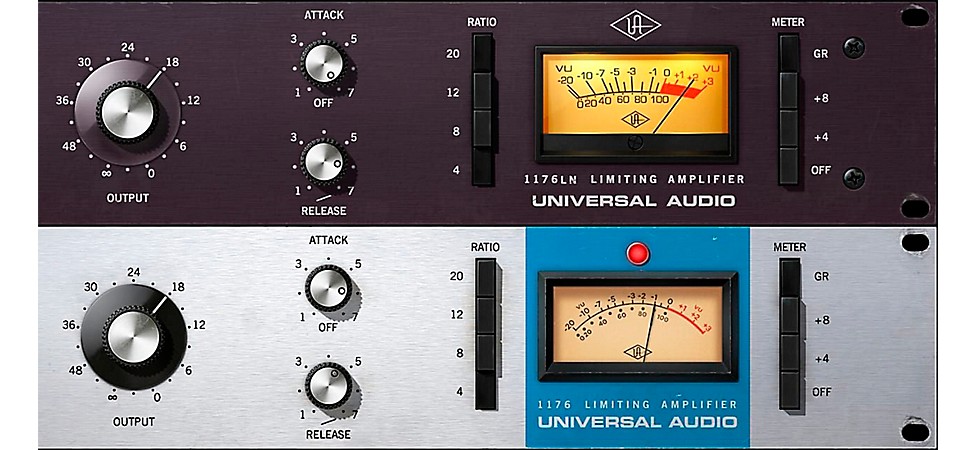
Pictured: Universal Audio 1176 Classic Limiter Collection
Universal Audio Volt USB Audio Interfaces
The Volt 176 is such an awesome option for home-recording musicians who work alone, or with a single collaborator at a time. You get a fantastic mic preamp and audio interface along with an onboard emulation of an 1176, and it works whether you record on a Mac or PC in your home studio, or like tracking on the go with an iPad or iPhone. Need another input? The Universal Audio Volt 276 USB Audio Interface gives you two input channels, each with a vintage mic preamp and 1176 emulation, which ups the versatility factor by letting you record a vocal and guitar simultaneously, or overdub two musicians at once.
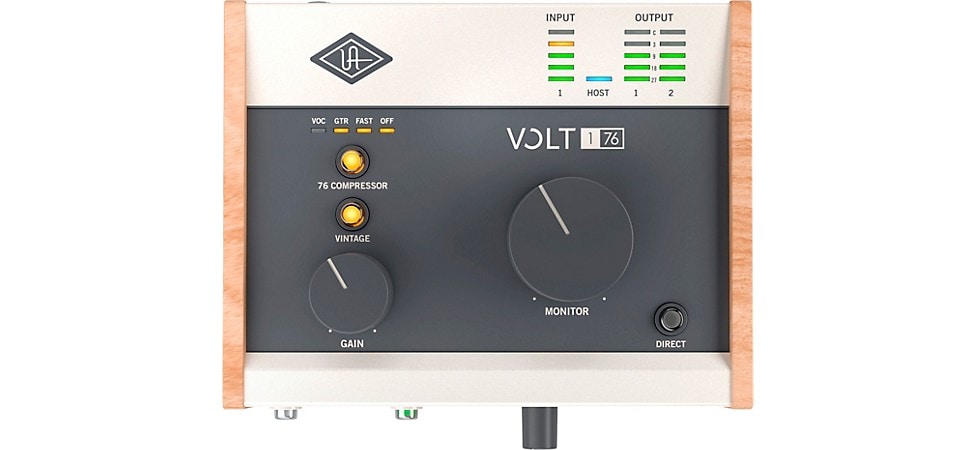
Pictured: Universal Audio Volt 176 USB Audio Interface
The Universal Audio Volt 476 USB Audio Interface ups the input count to four—although the goodies remain on input 1 and 2 (combo jacks, vintage mic preamps and 1176). Inputs 3 and 4 are dedicated 1/4" inputs for adding direct signals from instruments such as keyboards, guitars, bass and electronic drums. You can upgrade your home studio to more of a band-ready recording space with the four, full-featured inputs on the Universal Audio Volt 476P USB Audio Interface. Thanks to the combo jack, vintage mic preamp and 1176 compressor switch on each input, you can now record, say, an instrumental duo with each of their guitars miked in stereo—and with all with the vibe and presence you want. You could even overdub a drum kit on a track, using the four inputs for kick, snare and stereo overheads. The 476P is a good option for getting your miking chops together before you take the big step to going pro by investing in 24-channel audio interfaces and beyond.
A List of Compressors Inspired by the Universal Audio 1176
You can’t be an icon for so many years, and not have other manufacturers devise their own versions of your magnificent machine. Whether these homages are due to someone being so inspired by an 1176 that they wanted to try their own take on greatness, or a business decision by a manufacturer to ensure they offer a revered vintage processor in their lineup, the advantage goes to the creators, as they benefit from so many options for sound sculpting and experimentation. Here are some notable hardware and software tributes to the sensation that was and is the Universal Audio 1176.
The Warm Audio WA76 Discrete Compressor is a hardware processor modeled after the D revision of the 1176.
Multiple Grammy Award winning mix engineer Chris Lord-Alge offered up his favorite, heavily modded blue-stripe 1176—“Bluey”—to be modeled for the Black Lion Audio Bluey Modified Blue Stripe Compressor. The company also offers its take on a what a modern, hyper-drive 1176 would sound like, the Black Lion Audio Seventeen.
The Slate Digital FG-116 Blue Series FET Compressors plug-in is based on the original, version A 1176, and offers two vintage and one modern emulation.
A black-panel 1176LN, revision E was modeled for the IK Multimedia Black 76 Limiting Amplifier plug-in.
Imagine a vintage 1176 with the modern advantages of pre-delay, an advanced sidechain function and a steady output level (no matter how hard you crank the input gain), and you’d have the Arturia Comp FET-76 plug-in.
Designed for mixing and mastering, the Overloud Gem Comp76 Legendary FET Compressor plug-in delivers vintage 1176 tone coupled with new features such as mid-side processing (separate compression of mono and stereo elements) and parallel compression (manages overall impact while leaving transients intact).
The PSP Audioware FETpressor plug-in offers ’70s FET compression along with an internal, sidechain high-pass filter, adjustable ratio, dry-signal blend and more.
For an 1176 emulation with a continuously variable Ratio control—plus nine other compressors, including a Fairchild 670, Neve 33609 and custom models—try the McDSP 6030 Ultimate Compressor plug-in.
One Caveat to the Brilliance of the Universal Audio 1176—By Its Inventor
The Universal Audio 1176 has been a sonic component of so many smash hits, classic tracks, deep cuts, near misses and unheard gems that it’s impossible to count them all. Small wonder the 1176 is still in production today, and has inspired a bountiful marketplace of 1176-inspired hardware, plug-ins and interfaces. The 1176 has proven time and time again that it can help elevate a great song production into something astounding. But take care that you don’t fall completely under the 1176’s spell. The man who invented this marvelous gadget—Bill Putnam Sr.—knew full well that it wasn’t exclusively the sound of the 1176 that captivated listeners.
“Recording technology fascinated my father,” said Bill Putnam, Jr. “But at the end of the day, it was just a tool to get to a musical performance. He always said musicians were his favorite people. His love of the technology rubbed off on me first, but it was the music that was everything to him.”








